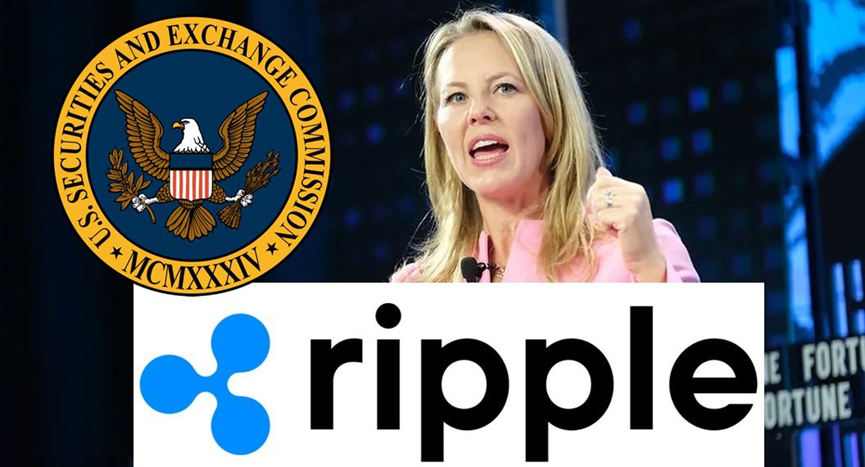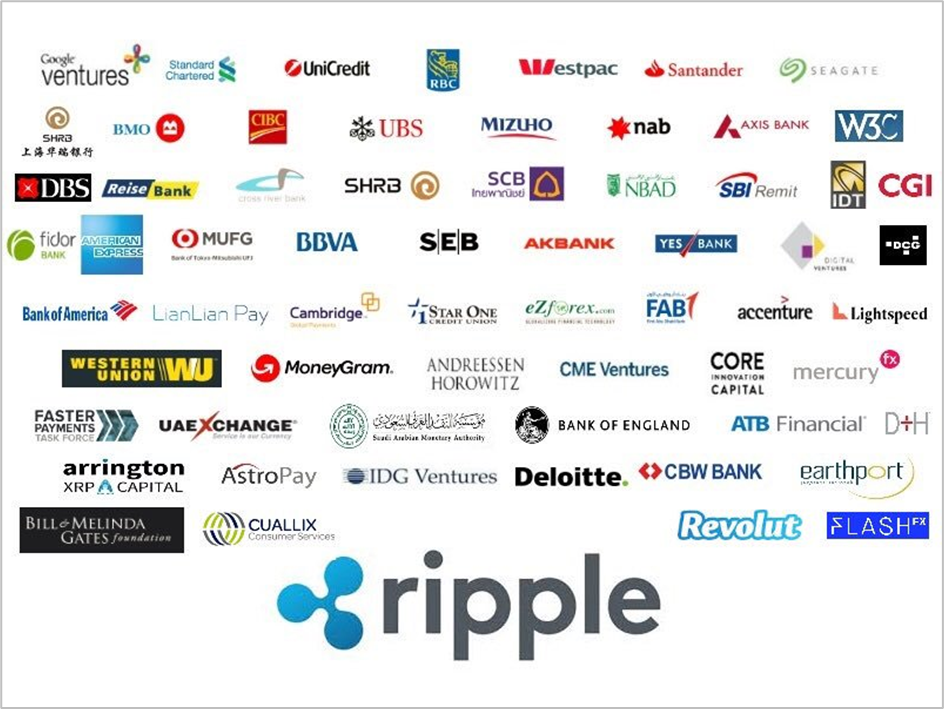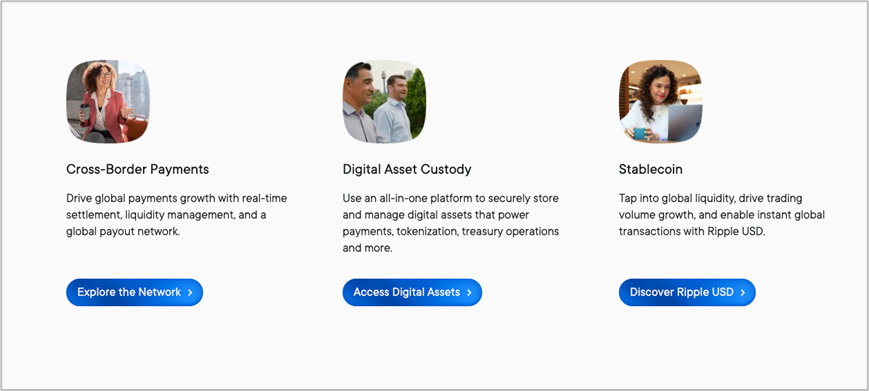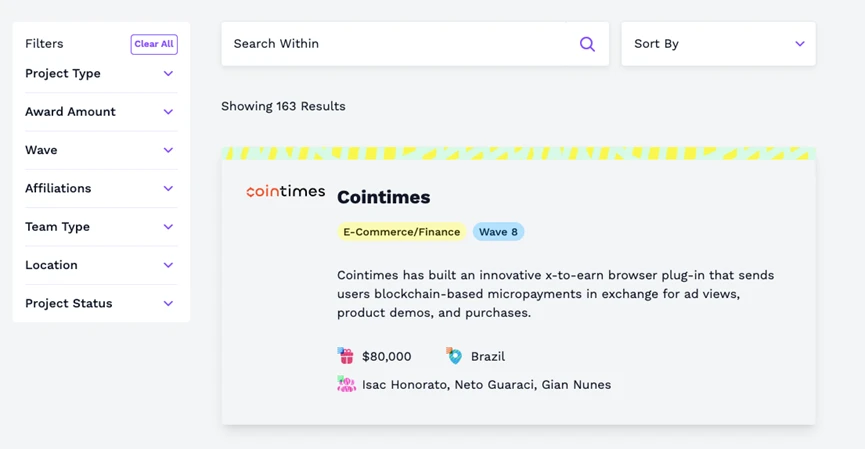Author: Daniel Li, CoinVoice
Recently, the cryptocurrency market has welcomed multiple positive developments, with Ripple (XRP), a veteran public chain, becoming the focus of attention. The news of U.S. Securities and Exchange Commission (SEC) Chairman Gary Gensler's impending departure has ignited market expectations for a more favorable regulatory environment. Meanwhile, the long-standing legal dispute between Ripple and the SEC is also expected to reach a resolution, as court rulings have repeatedly sent positive signals for Ripple, clearing some developmental obstacles for XRP. This series of favorable developments has propelled XRP's price to a strong rebound, surging over 250% in just one month, with a single-day increase exceeding 35%, reaching a nearly three-year high and reigniting investor enthusiasm.
As one of the pioneers in the blockchain field, XRP has focused on cross-border payment scenarios since its launch in 2012, gaining favor from financial institutions due to its efficiency, low cost, and technological innovation. However, the growth path of this classic token has not been smooth, facing pressure from market competition and frequent setbacks due to regulatory controversies. Now, with the regulatory environment gradually shifting and market confidence being boosted, XRP seems to be seizing this historic opportunity to redefine its future market positioning. As a "veteran" in the cryptocurrency field, can XRP once again carve out an innovative path and lead the future of blockchain payments? Let's explore.
01. Regulatory Favor: SEC's Revenge Concept Coin XRP Hits Three-Year High
With the 2024 U.S. presidential election concluded, Republican candidate Donald Trump has been elected as the next president with a high vote count. During his campaign, Trump promised to make the U.S. the "global cryptocurrency capital" and strongly supported the crypto industry, a stance that undoubtedly brought significant confidence to the market, driving up the prices of several cryptocurrencies, including XRP. In this wave of market recovery, XRP, dubbed the "revenge concept coin," has experienced a turnaround, reaching a three-year high and becoming the focus of investor attention. However, XRP's rise is not solely due to Trump's campaign promises but also stems from a series of changes in the regulatory environment and key progress in Ripple's four-year arduous litigation with the SEC.
Regulatory Changes Bring Catalysts to the Market
Since the end of 2020, Ripple has been sued by the SEC for allegedly raising funds through unregistered securities, subjecting XRP to four years of regulatory pressure. The SEC accused Ripple of issuing XRP since 2013, raising $1.3 billion, and claimed that its actions violated securities laws. This lawsuit not only caused a significant drop in XRP's price but also forced multiple exchanges to suspend XRP trading, severely damaging market confidence.
However, as the legal dispute gradually approaches its conclusion in 2024, XRP has welcomed a long-awaited turnaround. In 2023 and 2024, New York Federal Judge Analisa Torres made rulings that brought significant breakthroughs for Ripple. She determined that Ripple's sale of XRP to retail investors did not violate securities laws, while sales to institutional investors were deemed illegal, resulting in a $125 million fine for Ripple. This ruling is significantly lower than the SEC's initial demand for a $2 billion fine and leaves room for Ripple's future operations. More importantly, this ruling has released signals to the market regarding XRP's future development, alleviating excessive concerns about regulation.

New SEC Chairman May Bring More Favorable Developments for XRP
Another important factor driving XRP's recovery is the news of SEC Chairman Gary Gensler's departure. Gensler has been one of the most controversial regulators in the cryptocurrency industry in recent years, and his strict regulatory policies have once plunged many crypto projects into difficulties. However, with Gensler set to leave in January 2025, market expectations for the new SEC chairman have surged. Many anticipate that the new SEC leadership may adopt a more lenient and friendly attitude toward the crypto industry, bringing hope to XRP and other projects that have faced regulatory pressure.
According to The Washington Post, Trump's advisory team is evaluating several candidates for SEC chairman, including officials and financial executives who have publicly supported cryptocurrencies. The market generally believes that these candidates may take a more favorable stance on cryptocurrency regulatory policies. If the new SEC chairman indeed pushes for a policy shift as expected, Ripple's lawsuit may reach a settlement or even be dismissed, fundamentally changing the regulatory environment for the entire cryptocurrency industry. This would undoubtedly be a significant policy boon for previously suppressed projects like Ripple, Binance, and Coinbase.
Ripple Changes Litigation Dilemma Through Political Action
Ripple's "revenge path" relies not only on legal and regulatory changes but also on the company's active involvement in the political arena as part of its strategy. According to CoinDesk, Ripple Labs has injected $25 million into the Fairshake Political Action Committee (PAC) in the cryptocurrency industry, aiming to influence the 2026 U.S. Congressional elections and promote more favorable cryptocurrency regulatory policies. This move marks the company's beginning to leverage political means to attempt to reverse its litigation dilemma with the SEC and secure a more favorable legal and regulatory environment for XRP.
Additionally, Reuters reports that several cryptocurrency companies, including Ripple, Circle, Kraken, Coinbase, a16z, and Paradigm, are vying for seats on the cryptocurrency advisory committee that Trump plans to establish. This committee will become an important platform for cryptocurrency policy reform, and participating companies will have the opportunity to directly influence future policy directions, especially under the cryptocurrency-friendly policy framework promoted by the Trump administration. If Ripple can secure a position in this process, it will be able to advocate for more support for XRP at the policy level, thus gaining more freedom in the future regulatory environment.
02. XRP: Innovator of Traditional Financial Payment Systems
Over the past few decades, the global financial payment system has been dominated by traditional bank settlement and payment methods. Although these systems have certain advantages in terms of stability and security, the deepening of globalization and the rapid development of e-commerce have exposed a series of pain points in traditional financial payment systems that need to be addressed. High transaction costs, inefficient payment processing speeds, and the complexity and high costs of cross-border payments have become bottlenecks hindering global financial liquidity and market development. To address these issues, Ripple has launched XRP and the XRP Ledger, quickly emerging as a significant force in driving the innovation of traditional financial payment systems with its innovative technological architecture and unique business model.
What are XRP and Ripple?
XRP is the native cryptocurrency of the Ripple network and one of the core technologies designed by Ripple to address the pain points of the global payment system. Unlike traditional payment methods such as bank transfers and SWIFT, XRP provides a new solution for global payments through blockchain technology. Ripple significantly enhances transaction speed, reduces costs, and offers the ability to connect different currencies across borders through its innovative Ripple Protocol Consensus Algorithm (RPCA) and decentralized XRP Ledger. Essentially, XRP serves as a bridge currency, enabling efficient and low-cost exchanges between different fiat currencies, providing a smoother path for global payments and cross-border settlements.
Founded in 2012 by Chris Larsen and Jed McCaleb, Ripple is a technology company dedicated to driving innovation in the financial system. The company's initial goal was to transform existing financial payment systems through blockchain technology, particularly addressing the high costs and inefficiencies in traditional bank settlement systems. Ripple's vision is not only to create a new cryptocurrency but also to establish a decentralized and global financial network that connects banks, payment service providers, and financial institutions worldwide through RippleNet, achieving faster, cheaper, and more efficient payments and transactions.
Technical Advantages of XRP: Efficiency, Low Cost, and High Throughput
One of XRP's greatest advantages lies in its use of the XRP Ledger (XRPL) technology architecture. Unlike traditional blockchain projects like Bitcoin and Ethereum, XRP employs a unique consensus mechanism known as the Ripple Protocol Consensus Algorithm (RPCA). This algorithm does not rely on traditional proof-of-work (PoW) or proof-of-stake (PoS) mechanisms but achieves consensus through a group of independent validator nodes, ensuring the validity of transactions. This design allows the XRP network to complete transaction validation in seconds, with transaction fees being relatively low, typically only 0.00001 XRP, significantly reducing the high transaction fees and time delays commonly seen in traditional financial payments.
Compared to Bitcoin's transaction processing speed of only 7 transactions per second, the XRP Ledger can process up to 1,500 transactions per second, and with ongoing technological optimizations, future throughput is expected to increase further. This efficient transaction processing capability makes XRP an ideal choice for cross-border payments and fund transfers, especially in scenarios requiring quick settlements and large payments, where XRP demonstrates unparalleled advantages.

XRP's Role in the Global Payment System: Innovation in Cross-Border Payments
One of XRP's core advantages is its ability to provide efficient and low-cost payment solutions between different countries and regions, particularly in the field of cross-border payments. Traditional cross-border payments typically rely on multiple intermediary banks and complex settlement processes, which not only increase the time cost of transactions but also make payment fees exorbitant. According to data from the Society for Worldwide Interbank Financial Telecommunication (SWIFT), traditional cross-border payments usually take 2 to 3 business days, with fees typically ranging from 5% to 10% of the payment amount. This inefficient and costly payment method has become a bottleneck in global financial transactions and business activities.
XRP, through its innovative On-Demand Liquidity (ODL) technology, has completely changed this situation. ODL technology allows users to make instant cross-border payments using XRP as a bridge currency without pre-funding. For example, when a business wants to transfer funds from the U.S. to Japan, the traditional method requires relying on multiple intermediary banks and may take several days to complete the transaction. However, with XRP, users can complete the payment in seconds, and the fees are far lower than traditional payment methods. This efficient, convenient, and low-cost payment method greatly enhances the efficiency of global trade and capital flow.
Ripple has gradually established a wide payment network globally through partnerships with various banks, payment service providers, and financial institutions. This enables XRP to play a significant role not only in traditional finance but also to achieve breakthroughs in payment and remittance in emerging markets and developing countries, further promoting financial inclusion.
Advantages of Ripple and XRP: A Combination of Bank Collaboration and Decentralization
XRP's success in the global payment system is closely tied to its deep collaboration with traditional banks and financial institutions. Ripple has always adhered to the philosophy of "collaborating with traditional financial institutions rather than opposing them," allowing XRP to gain rapid promotion within existing financial infrastructure through partnerships with leading financial institutions worldwide. For example, Ripple has engaged in strategic collaborations with major banks and payment platforms such as Bank of America, Credit Suisse, and Mitsubishi UFJ Financial Group to promote the application of XRP in cross-border payments and settlements. These partnerships not only enhance XRP's market recognition but also lay a solid foundation for its further expansion into the financial services sector.
However, the integration of XRP with the traditional banking system does not mean it loses its decentralized characteristics. The XRP Ledger is a decentralized public blockchain that anyone can join and become a validator node. This means that even if Ripple were to cease to exist, the XRP network could continue to operate. The decentralized design ensures that XRP is not controlled by a single entity, which is a key advantage distinguishing it from traditional financial systems.
In the future, XRP may not be limited to cross-border payments; its application potential in emerging fields such as decentralized finance (DeFi) and asset tokenization is also worth looking forward to. As Ripple continues to strengthen its collaborations with global banks and financial institutions and promotes the implementation of XRP in more financial areas, XRP is expected to become an indispensable part of the global payment system, evolving into a new global currency.
03. From Traditional Finance to the Web3 Industry: Ripple's Long-Term Layout and the Future of XRP
Although Ripple is a blockchain company, its primary focus has historically been on the traditional financial sector. With the rapid development of global fintech, the transition from traditional finance to the Web3 industry has become a mainstream trend in the financial market, and Ripple has begun to gradually lay out its strategy in the Web3 sector. However, unlike many cryptocurrency projects, Ripple has not limited its vision to merely the digital currency space but is advancing the diversification of its products and services from a broader perspective. Ripple is focusing on decentralized finance (DeFi), stablecoins, and asset tokenization within the Web3 domain. Notably, while XRP itself does not play a direct role in these strategic directions, Ripple's long-term layout provides broader application prospects for XRP's future.

Ripple's Steady Strategy: Compliance as a Foundation, Expanding Web3 Collaborations
In contrast to many cryptocurrency projects that pursue quick gains and speculative practices, Ripple has consistently adhered to a robust core strategy, committed to promoting innovation within a compliance framework. Throughout its four-year litigation with the U.S. Securities and Exchange Commission (SEC), Ripple's strategic direction has become increasingly clear, further reinforcing its philosophy of steady development. From initially positioning XRP as a cross-border payment tool to now actively laying out Web3, Ripple has maintained compliance and closely collaborated with traditional financial institutions. This strategy not only enhances market trust in Ripple but also makes its layout in the Web3 sector more forward-looking and sustainable.
In terms of compliance, Ripple has achieved significant accomplishments. The company and its subsidiaries hold nearly 40 U.S. money transmission licenses, a New York BitLicense, a major payment institution license from the Monetary Authority of Singapore, and registration as a Virtual Asset Service Provider (VASP) with the Central Bank of Ireland, ensuring its legal operations in multiple countries and regions. These qualifications provide Ripple with strong compliance assurance and further enhance its credibility as a global financial service provider.
Ripple's global network of partnerships also provides strong support for its expansion in the Web3 sector. The company has established deep collaborations with over 100 banks and financial institutions worldwide, including well-known institutions like Santander Bank and Mitsubishi Bank. These partnerships not only enhance Ripple's influence in the traditional financial sector but also provide more practical application scenarios for XRP. Additionally, Ripple collaborates with platforms like Archax to actively promote the tokenization of real-world assets (RWA), helping traditional financial assets smoothly enter the blockchain ecosystem. At the same time, Ripple is also laying out in the "institutional-grade DeFi" space, creating new opportunities for further collaboration with financial institutions by investing in projects like tokenized government bonds through partnerships with platforms like OpenEden. Recently, the XRP ETF proposals submitted by companies like Bitwise Asset Management have sparked widespread market attention regarding Ripple's future potential, further validating its strategic advantages in the integration of Web3 and traditional finance.
XRP and Web3: Challenges and Opportunities in Adapting to Transformation
While Ripple has gradually shifted its strategic focus from traditional cross-border payments to the Web3 sector, this does not mean that the XRP token can seamlessly adapt to this transformation. Unlike the traditional cross-border payment market, the core values of the Web3 industry lie in decentralization, digital asset liquidity, and the application of smart contracts, which fundamentally change XRP's role in Web3 compared to its function as a bridge currency in cross-border payments. Although XRP's technical advantages and efficient transaction mechanisms remain commendable, its biggest challenge in the Web3 ecosystem is how to closely align with the demands of emerging fields like decentralized finance (DeFi). To find a new positioning in this emerging field, Ripple must further promote the deep integration of XRP with Web3.
Ripple is expanding the application scenarios of XRP through various initiatives, gradually penetrating other key technological areas of the Web3 industry. According to BlockBeats, on November 30, FOX Business cited informed sources stating that the New York Department of Financial Services has indicated it will approve Ripple's launch of a new stablecoin product—RLUSD, which is planned to be officially launched on December 4. In the future, the RLUSD stablecoin will serve as a complementary tool to XRP, enhancing its role in Ripple's payment solutions. This strategy not only helps solidify XRP's market position in the payment sector but also opens up new opportunities for its application in Web3. Additionally, Ripple is actively promoting the construction of the XRPL ecosystem by funding developers and supporting innovative applications in the global Web3 space. Through these initiatives, Ripple is leveraging XRP as a foundation to actively drive the development of Web3 technology, providing innovative solutions for emerging fields like decentralized finance (DeFi).

What Does the Future Hold for XRP?
Following Trump's election, the cryptocurrency industry holds an optimistic view of future regulatory policies, bringing new opportunities for the traditional financial sector that has long sought to enter the crypto market. As Ripple has long been deeply involved in traditional finance, its potential and influence in cross-border payments have attracted significant investor attention. The recent price trends of XRP also reflect this trend, as XRP recently broke through a dynamic resistance level that had stood for five years. Some optimistic crypto analysts believe that XRP's next target price could reach $4.20, and with market sentiment and favorable policies, XRP is expected to break through the historical high of $3.317 set in 2018 in the short term.
However, the future prospects for XRP still face considerable controversy. On one hand, the new SEC chairman has yet to be determined, which leaves Ripple facing some regulatory uncertainty and potential compliance risks. On the other hand, since XRP's launch in 2012, its performance has not been as outstanding as expected. Although Ripple has announced plans to utilize XRP for cross-border payments, there are few signs indicating that XRP's actual usage frequency in global financial services has met the anticipated goals. Furthermore, Ripple has not publicly disclosed the profitability of its cross-border payment business, relying more on the sale of XRP tokens to sustain operations, leading to substantial benefits for its founding team and shareholders. Notably, the vast majority of XRP tokens remain held by Ripple, and the company sells a certain amount of XRP each quarter.
Moreover, XRP's past performance has not significantly changed public perception of its potential in the Web3 sector, leading some investors to question its future market role. However, Ripple has clearly recognized this challenge and is taking proactive measures to enhance XRP's future development potential. Recently, Ripple launched the RLUSD stablecoin to expand the XRPL ecosystem, and some institutions like Bitwise Asset Management have also submitted XRP ETF proposals. These initiatives indicate that XRP remains a key component of Ripple's future development. Despite facing challenges, the future of XRP is still worth looking forward to.
免责声明:本文章仅代表作者个人观点,不代表本平台的立场和观点。本文章仅供信息分享,不构成对任何人的任何投资建议。用户与作者之间的任何争议,与本平台无关。如网页中刊载的文章或图片涉及侵权,请提供相关的权利证明和身份证明发送邮件到support@aicoin.com,本平台相关工作人员将会进行核查。




